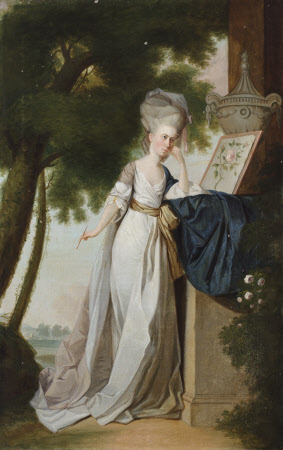Frances Delaval, Mrs Fenton Cawthorne (1759 - 1839), with a watercolour of a rose, in a landscape
attributed to Edward Alcock (fl.1745 - 1778)
Category
Art / Oil paintings
Date
1775 - 1778
Materials
Oil on canvas
Measurements
914 x 559 mm (36 x 22 in)
Order this imageCollection
Seaton Delaval Hall, Northumberland
NT 1276776
Caption
The frame tablet on this portrait identifies the sitter as Rhoda Delaval (1725 – 1757), but comparison with a similar picture in a private collection has shown that she is, in fact, from the next generation of Delavals. Frances was the fifth daughter of Sir John Hussey Delaval. In August 1778, she married John Fenton of Lancaster, who, in 1781, inherited a modest estate at Wyreside in Lancashire, and became Mr Fenton Cawthorne. He was elected M.P. for Lincoln in 1783, but when the time came for re-election in 1790 he had to battle against two contenders. As a consequence he spent too much on his campaign, unwittingly bankrolled by his father-in-law, who, as a consequence, cut them off. Frances did not resume correspondence with her father for some ten years. The artist was probably the Alcock living and working in Bath in 1757. In 1759/60 he was living at Birmingham, and by 1778 he was in London 1778. His signed and dated portraits range from 1762 to 1774, including neat, small full-lengths in the style of Devis.
Summary
Oil painting on canvas, Frances Delaval, Mrs Fenton Cawthorne (1759 - 1839), with a watercolour of a rose, in a landscape, attributed to Edward Alcock (fl.1745 - 1778). Full-length portrait, standing, wearing a white silk dress with a blue wrap, her head resting on her left hand, a paintbrush in her right; her painting of a rose rests on a plinth and against an urn, to the right, and a landscape lies beyond.
Full description
Fifth daughter of Sir John Hussey Delaval; married, in August 1778, John Fenton of Lancaster, who, in 1781, inherited a modest estate at Wyreside in Lancashire, and became Mr Fenton Cawthorne. He was elected M.P. for Lincoln in 1783, but when the time came for re-election in 1790 he had to battle against two contenders. He spent £2500 on his campaign, most of it unwittingly bankrolled by Sir John, who insistent on being repaid, forced Cawthorne to sell assets and he cut France’s allowance. He joined the army as a Colonel, but the pitiful wage did little to settle his debts and he was eventually court-martialled for embezzling funds and bribery, which resulted in his being expelled from the Commons in May 1796. Frances loyally stood by him, and by 1801, appears to have been in correspondence with her father. Having paid off some of their debts, by 1807 they were reunited, and in a letter of that year she thanks him for a draft of £125. She died in 1839, the last of her generation. (see M. Green, The Delavals. A Family History, Newcastle, 2007, pp.99-102) There is a version in a private collection, of better quality. cf. also the group portrait by the same artist in a private collection, showing her to the right, her head resting on her right hand (in reverse of the present picture). That the frame is inscribed with her name, Mrs Cawthorne (i.e. after her marriage in 1778, and her husband’s appropriation of the name ‘Cawthorne’ post 1781) does not negate the attribution to Alcock (d. 1778), as it appears to be a later inscription (but still much earlier than the 20th tablet with a misleading identification on the present picture). The attribution was suggested by Anthony Mould. The artist was probably the Alcock living and working in Bath in 1757. In 1759/60 he was living at Birmingham, and by 1778 he was in London 1778. He must be the Alcock (no initial) who exhibited small portraits and genre pictures at the RA in 1778. His signed and dated portraits range from 1762 to 1774, including neat, small full-lengths in the style of Devis (cf., in particular, the portrait of Giles Bridges, Duke of Chandos (30 x 25 ins., sold Doyles, N.Y., January 24th 2001, lot 101), which shares the same attenuation of the body, pinched facial features, and the setting of the figure in context.
Provenance
accepted in lieu of tax by H.M. Treasury and transferred to the National Trust in 2009.
Marks and inscriptions
Frame tablet: RHODA DELAVAL b.1725 d.1757 daughter of / Capt. Francis Blake Delaval R.N. and / wife of Sir Edward Astley, Bart. / TILLY KETTLE
Makers and roles
attributed to Edward Alcock (fl.1745 - 1778), artist Tilly Kettle (1735 - Aleppo 1786), artist previously catalogued as attributed to William Bell (c.1735 - 1794), artist Hugh Barron (London c.1747 – London 1791), artist
